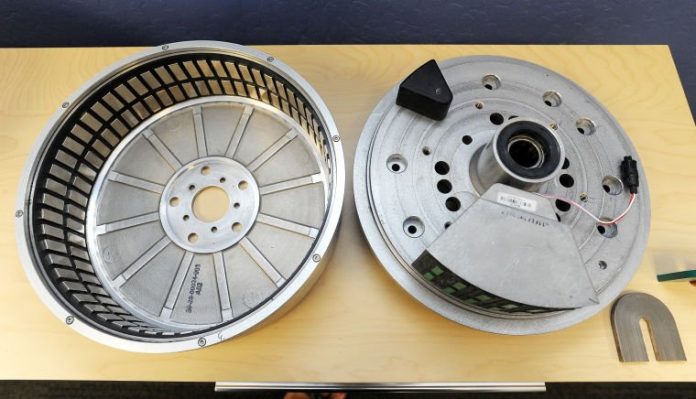
Technology that could revolutionize the use, deployment and growth of electric motor vehicle systems used for powering plug-in vehicles and scooters worldwide is being produced by a Morgan Hill company co-founded by a Live Oak High School dropout.
KLD Energy Technologies, which is based in Austin, Texas, but does its research and development in Morgan Hill, has spent the last few days introducing the public to its patented oneDRIVE electric propulsion system, which is touted by its developers as vastly more efficient and safer than existing technology – including that used by American mega-manufacturers Tesla and General Motors.
KLD co-founder and Chief Scientific Officer Ray Caamano, a 50-year-old Gilroy resident, said the system could go a long way in reducing energy consumption worldwide – a mission he has been passionate about for the past three decades or so in which he has taught himself enough about mechanics, electricity and engineering to invent the key components used in the oneDRIVE engine.
“We have this very serious problem – how do we stop burning all this fossil fuel?” said Caamano. “The internal combustion (gas-powered) engine has only 25 percent maximum efficiency. We could do a lot more with a lot less, and we would have less pollution and less political problems. This is driving the revolution in transportation.”
The oneDRIVE system consists of three primary components – the motor, battery and motor controller – that were developed in-house at KLD’s Morgan Hill lab which employs 10 people.
Three vehicles containing the oneDRIVE engine were on display outside KLD’s Morgan Hill facility on Vineyard Boulevard last week. Two were commercial vehicles – a two-wheeled scooter and a miniature pickup.
The third was an open frame ensemble resembling a go-kart, with the oneDRIVE components bolted to the back and prominently on display. Caamano and John Bautista, KLD Business Development and Research Manager, offered this third vehicle for a test drive.
The absence of gears and the lack of engine noise were the most immediately noticeable differences between the electric vehicle and the tester’s multi-valve six-cylinder-powered Japanese sedan. The battery recharges via a standard wall outlet, and the motor also regenerates power to the battery while in transit.
The plug-in electric vehicles employing the oneDRIVE system have a maximum speed of 55 mph. By contrast, Tesla touts top speeds of 125 mph and higher for its various models.
The oneDRIVE motor, using technology patented by Caamano, has only one moving part, no gear box and no oil. It propels the driveshaft using electromagnetic power. The lack of the “thousands” of moving parts that expend valuable energy and are found in most other vehicles – even electric ones – is what makes the oneDRIVE system so efficient, Caamano explained.
Standard electric vehicle motors today are still using modifications of the “induction” system that was invented more than 100 years ago, Caamano said.
KLD’s battery and motor controller designs are also unique to other manufacturers, and enlist more of Caamano’s own inventions.
Designing the battery has been the most “painstaking” part of the process, Caamano said. The 53-pound battery box contains nearly 500 rechargeable lithium battery cells identical to those used in cordless power tools. The oneDRIVE battery maxes out at 48 volts – much lower than the batteries of competitors, but with the ability to deliver just as much if not more power.
KLD unleashed the oneDRIVE system in time for what promises to be a bright future for electric vehicles. According to a recent report from Navigant Research, sales of plug-in electric vehicles are expected to reach about three million, or three percent of the global light-duty vehicle market, by 2020.
“(The) PEV market continues to grow rapidly – about 150 percent between 2011 and 2012 – but remains a very small part of the overall global automotive market, with 0.2 percent market share in 2012,” the report published in June 2013 says.
Caamano thinks the oneDRIVE system’s simplicity and affordability will contribute to that growth.
KLD is focusing on placing its technology in more “utilitarian” uses, such as two-wheeled scooters and light-duty pickup designs, Caamano said. They’re also focusing largely outside the U.S. – in regions like Europe and Asia where the economy and infrastructure are already suited to electric vehicles.
Four-wheeled vehicles manufactured by Cenntro, employing KLD’s system will be available for about $15,000 to $25,000 in the U.S., Caamano said. Two-wheeled oneDRIVE-powered scooters made by V Moto will likely range from $4,500 to $5,500.
Electric vehicles popular on the American market include numerous models by Tesla (roughly $60,000), the Chevrolet Volt (as low as $26,685) and the Nissan LEAF (starting at $21,300).
While the oneDRIVE system is currently only deployed in electric-only vehicles, to soften consumers’ potential worries about the battery’s range of 60 miles, KLD engineers are also working on a hybrid engine in the back of their research lab. Early tests on that system, which are not yet available to consumers, show the hybrid can achieve more than 100 mpg.
Nearly five years ago, Caamano and Christian Okonsky formed KLD Energy for the sole purpose of developing the oneDRIVE system – the various parts of which Caamano had been working on for some time. Okonsky is now the CEO of the company. The two worked together previously at another company, and they shared the same passion for green alternatives to wasteful fossil fuels.
Caamano dropped out of LOHS in the late 1970s to run his Volkswagen repair shop at the time. Though he gained his GED, he never attended college or received a degree.
Inspired by Ferdinand Porsche and Nikola Tesla, Caamano spent the next 30-plus years studying mechanical and electromagnetic engineering on his own.
Porsche, he noted, took a “minimalist” approach to his automotive creations. That’s what Caamano had in mind as KLD developed the oneDRIVE patents. And it’s ultimately what will bring costs down and make electric vehicles available to more people, he said.
Bautista, a 1977 LOHS graduate who attended University of California, Davis, joined KLD Energy a couple years ago. Formerly the director for mechanical engineering at Zero Motorcycles – an electric motorcycle producer in Scotts Valley – Bautista has a “long history” with Caamano who helped him get in the door at KLD Energy.
“It was really where I wanted to be. I wanted to get with a company that had greater growth potential and an opportunity to make a bigger impact on the world,” Bautista said.












